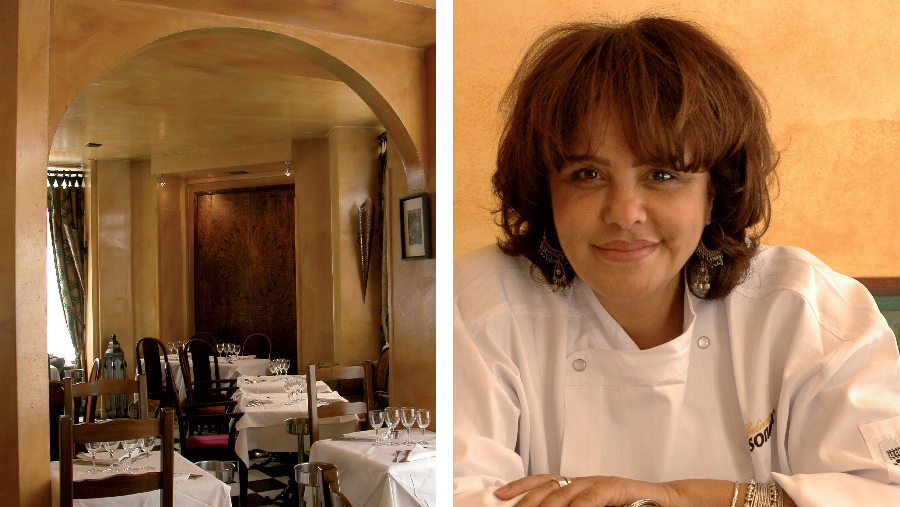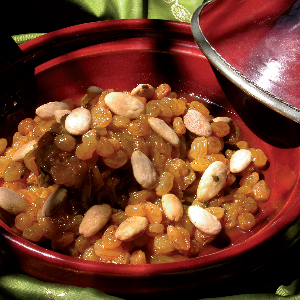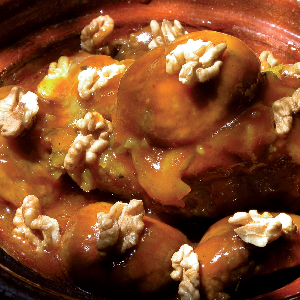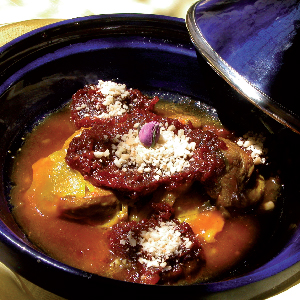The French media has paid a lot of attention to Fatéma Hal, not just because of her skills as a chef, but because she has proven to be the ideal example of how to achieve success through hard work and perseverance. As a child, Fatéma was destined for an arranged marriage, which was common in traditional Moroccan families (even in France) and once married, soon had three children. She decided that she wanted to make something of herself and turned her life around by going to university to study sociology. She was rejected by her family, leaving her without any money, and she was forced to work all hours to pay for her studies. Her career took her as far as advisor to the French minister for women’s rights. When she saw a restaurant that had gone bankrupt for sale, Fatéma knew all of a sudden, what it was she wanted to do. She wanted to start a restaurant. She had no money, yet developed a brilliant plan. She asked a large number of people to deposit 500 francs into her bank account in exchange for a voucher that they could use in her restaurant later on. The media went wild for the idea and the whole of France followed her story. Within a rather short amount of time, she had collected enough money for her plans. This was in 1984. After the restaurant had opened, serving the authentic Moroccan food she had learned to cook as a child, the business became a success almost overnight. Fatéma delved into the history of her chosen cuisine and went to Morocco in search of recipes lost over time. Every time she returned, her diners were chomping at the bit to taste her new food. This habit of collecting traditional recipes is based on Fatéma’s clear desire to protect and preserve the verbal traditions of the Berber people, which are gradually disappearing. In reality, this philosophy is the work of sociologists, something she studied in her past. What we learned from our visit with Fatéma, is that her cooking is all about techniques; not contemporary ones, but ancient ones. Having said this, La Mansouria is most definitely one hundred per cent committed to fine gastronomy. It is certainly not a ‘couscous restaurant’. The manners of North African culture dictate that one should always try a little of everything, which is precisely what we did. Fatéma served us about 20 different dishes, all with different flavours, techniques and combinations. She uses a lot of spices but they are always very subtle. The same goes for all the sugar she uses, which is no obstacle at all. We asked her what veal means to North Africa: “Veal is the most luxurious food in our culture. Obviously lamb and poultry play a much larger part in our cuisine, and veal is reserved for high society, the happy few. Yet this makes it a product for celebrations, one that is given an elaborate amount of attention.”
Soak the raisins in water for 30 minutes and soak the saffron in a separate bowl of water. Sweat 500g of onions in butter, oil, cinnamon, salt and pepper in a large cast iron pan. Deglaze with saffron water and simmer for a few minutes. Add the meat and the rest of the onions that are cut into rings. Deglaze with water and stew for 35 minutes. Mix the raisins with some cinnamon and the sugar and steam like couscous. Brown the almonds in a drop of oil and mix with the raisins. Place the meat in a tajine and cover with the raisin mixture.
Cut the meat into 6 pieces and place it in a cast iron pan with oil, finely-chopped onion, crushed garlic, ginger, saffron, chopped coriander and the water. Cook for 45 minutes stirring constantly. Cut the figs in half and put them in a large pan with the spices listed in the ingredients, and some water. Marinate for one hour. Remove the figs from the pan, fry in butter, add the honey and cook for 7 minutes. Take the pieces of meat out of the pan one by one and fry in butter in a different pan. Place the meat in a tajine. Pour in the sauce from the first pan, cover with some figs and sprinkle walnuts over the top.
Cut the meat into 6 pieces and finely chop the onion. Mix oil and butter in a hot pan and add the meat, seasoned with salt and pepper. Brown the meat and add saffron, ginger and cinnamon. Then add the water, cover with a lid and stew for 45 minutes. Peel the tomatoes and cut into small pieces. Cook these for 30 minutes in butter and oil on a low heat, stirring regularly. Add the rose petals, spices and honey, and keep stirring until it has reached the consistency of a preserve. Serve the meat with the sauce and chopped almonds.



